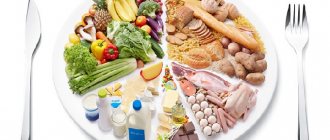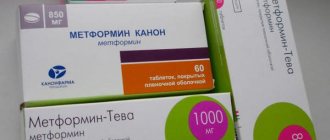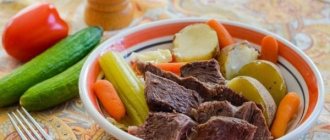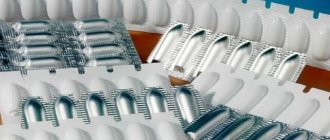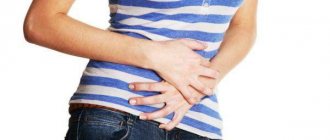Diabetes mellitus is a disease associated with an absolute or relative lack of insulin in the body and characterized by impaired carbohydrate metabolism and other metabolic disorders. Simply put, diabetes is not a disease in the full sense, but an incorrect lifestyle and diet. Therefore, nutrition for diabetes plays an important role in the patient’s well-being.
Today we will look at:
1.Foods to include and exclude from the diet for type 2 diabetes
2. Basic steps and rules of diet for type 2 diabetes
3. Nutrition for diabetes mellitus for BREAKFAST list of dishes
4. Meals for diabetes mellitus for LUNCH list of dishes
5. Meals for diabetes mellitus for DINNER list of dishes
Features of the diet for diabetics
Previously, a system of dietary restrictions was the only method to curb hyperglycemia or elevated glucose levels. Now the patients' diet has expanded significantly. Diabetics are advised to follow several important rules for effective blood glucose control.
Patients should not go hungry or overeat. These conditions are dangerous to their health. It is necessary to eat so that the amount of carbohydrates consumed is evenly distributed throughout the day.
General dietary requirements:
- split meals (at least 6 times a day);
- calculation of consumed carbohydrates;
- limiting animal fats;
- introduction of plant foods into the diet;
- preference for food steamed, oven-baked, or boiled;
- avoiding or limiting foods that increase carbohydrate load;
- balanced diet;
- replacing sugar with substitutes;
- consumption of coarse fiber foods;
- compliance with the drinking regime;
- reducing salt intake;
- excluding alcohol.
You can diversify your diet by purchasing cookware that allows you to cook food without oil.
To ensure that carbohydrates are absorbed more slowly and do not provoke spikes in blood sugar, you should adhere to the following recommendations:
- Eat food with a rough or grainy consistency, such as crumbly porridge instead of pureed or boiled.
- Dishes should not be hot, as temperature affects the absorption of glucose.
- Fiber in foods inhibits the absorption of simple carbohydrates and helps remove cholesterol.
- Simple carbohydrates are best consumed after the main meal.
The menu can include foods that contain simple carbohydrates with fiber, such as fruits and berries. The absorption of glucose slows down if consumed with proteins (protein cream) or fats. However, do not forget that “slow” carbohydrates are also absorbed into the blood, increasing sugar.
Food for diabetics: principles of cooking, diet depending on the type of disease
The vast majority of patients with diabetes constantly take glucose-lowering medications or are forced to inject insulin.
The principle of action of such drugs is different, but the therapeutic effect is the same - a decrease in blood glucose levels. In addition, the mode of their use is often closely related to meal times. Therefore, the main condition for proper nutrition in combination with drug therapy is strict adherence to food intake. Otherwise, there is a high probability of developing a life-threatening hypoglycemic state.
Currently, a huge range of household appliances are available, designed for preparing healthy and tasty food. If possible, you should get a steamer and a multicooker (by the way, this miracle saucepan also has a steaming function, and in some - the production of yoghurt).
Food for diabetics should be prepared using:
- stewing with minimal addition of butter or vegetable oil, for example, in a slow cooker you can do without it altogether;
- baking in the oven, this method is suitable for meat, poultry, fish, but first it is recommended to wrap them tightly in foil or a special sleeve;
- steam processing, so in a steamer you can cook meat, fish dishes, omelettes, puddings, casseroles, and cook any porridge;
- cooking in plain water, meat or fish broth.
Frying in a frying pan is allowed only for preparing onion and vegetable dressings for borscht, soups, and cabbage soup. This method is best avoided when preparing meat, fish or poultry dishes.
The principles of how to eat with diabetes vary somewhat depending on the type of pathology. In the case of the disease of the first form, when the body's production of insulin is significantly reduced and the patient is on constant insulin therapy, compliance with the diet is of primary importance. With type 2 diabetes, which often occurs in pensioners and people closer to 40–45 years of age, the risk of obesity is high. In this case, the diet should be aimed at optimizing and maintaining the desired body weight.
Differences in nutrition between type 1 and type 2 diabetes
Since the reasons for the increase in blood sugar in the first and second types of the disease are different, there are several approaches to the diet of patients. For insulin-dependent patients, the diet is more varied. Since people suffer from this pathology more often at a young age, high-calorie foods are included in the diet. When preparing a diet, the consumed grain units are taken into account.
In type 2 diabetes, the main goal of nutrition is weight loss. In this case, the menu is calculated based on the calorie content of the products. The patients' diet is stricter. They cannot eat sugar, fatty foods, or foods that increase cholesterol.
Bread unit
The concept of “bread unit” (XU) was introduced to take into account the quantitative composition of carbohydrates. 1 XE is considered to be 25 g of bread or 12 g of sugar (carbohydrates). The diagram of bread units is necessary for diabetics to calculate the administered short-term insulin.
For 1 XE, 2-4 units are required. insulin. The individual need for additional insulin administration according to XE is determined using a self-monitoring diary, which the patient must keep.
A diabetic should eat no more than 7 XE per meal. The main carbohydrate load occurs in the first half of the day. In order not to constantly calculate bread units by weight of products, we created tables of products taking into account their energy value.
What is the glycemic index of foods
The glycemic index (GI) is an indicator that indicates how much blood sugar can increase when consuming a particular product compared to taking glucose.
High GI foods (70 or more):
- honey,
- glucose;
- sugar;
- mashed potatoes;
- sweet soda;
- sweets - corn sticks, puffed rice.
Average GI (56-69):
- melon;
- banana;
- oatmeal;
- black bread.
The lowest GI are:
- dairy products;
- milk;
- fruits;
- peas, beans, lentils and other legumes.
The rate of absorption is affected by cooking, food integrity and temperature.
For diabetes mellitus, only foods with medium and low GI are allowed.
Reminder for a patient with diabetes mellitus
Dieting can be comfortable and simple if you know what you can lose and gain as a result. In order for such a menu to be enjoyable, in case of diabetes mellitus, it is necessary to place a reminder for the patient within daily visibility and periodically re-read:
- Sugar and white flour do not contain a single component necessary for the body; avoiding them improves the condition of the skin, slows down aging, and strengthens bone tissue.
- Focus on what you can eat without restrictions - non-starchy vegetables, all types of salad, greens, drinks and desserts with stevia. Prepare a large bowl of salad and eat it during the day with fish, tofu, and Adyghe cheese.
- If you feel hungry between meals, then introduce food bran into your diet, they promote a feeling of fullness and cleanse the intestines, and drink water with a slice of lemon half an hour before meals.
- Food should be freshly prepared, warm and appetizing. To do this, spices and herbs are added to dishes.
- It takes 21 days to acquire any habit, set yourself the goal of maintaining proper nutrition during this period, then it will be much easier.
- Prohibitions do not work; what is not allowed arouses even stronger interest than before the restrictions. Just choose the products you need in the store, or even better, at the vegetable market.
- To give up a harmful but favorite product, find information about it, watch a video about why you shouldn’t eat it, write yourself (!) ten reasons why you need to get rid of it, re-read the list and add new items to it.
- Physical activity is the best way to tone the body; in diabetes, it is considered a healing factor. If there are no contraindications, then first walk in the fresh air for at least half an hour. If you add 5-10 minutes to this time every day, you can significantly reduce the risk of vascular disease.
List of permitted and prohibited products
Diet guidelines for diabetics with different types of the disease vary. However, there are dishes that endocrinologists do not recommend eating.
The list of prohibited products includes:
- potatoes - fried, fries, chips;
- sweet fruits - grapes, pears, bananas;
- fatty meats;
- smoked meats;
- canned food in oil;
- pates;
- sweet cheeses, curd mass;
- sweet yoghurts;
- margarine;
- white bread and pastries made from white flour;
- juices from the store;
- soda;
- alcohol;
- candies, chocolate;
- jam;
- condensed milk;
- fast food.
Patients will love the following foods and drinks:
- mineral water;
- rosehip compote;
- vegetable juices;
- freshly squeezed juices from sweet and sour berries and fruits;
- unsweetened citrus fruits;
- frozen and fresh berries;
- low-fat fermented milk products without sugar;
- dietary meat - chicken, turkey, veal, rabbit;
- cabbage;
- legumes;
- mushrooms;
- tomatoes;
- eggplant;
- greenery;
- asparagus;
- broccoli;
- milk;
- baked goods made from wholemeal flour;
- seafood;
- fish.
To reduce the starch content in vegetables and cereals, it is recommended to soak them before cooking.
Products to avoid
Foods that do not meet the requirements of a diabetic diet should not be eaten. No matter how low your glucose levels are at a particular moment. A sick person should avoid foods high in simple carbohydrates. The following sweets are prohibited: confectionery (pastry, cakes, sweet pastries), candies, white and milk chocolate, marshmallows and marshmallows, ice cream.
As for fruits: fructose is broken down in the body without the participation of insulin. The rate of breakdown of fruit sugar depends on the glycemic index of the product. When the reaction has occurred and glucose appears in its pure form, insulin is needed to transport it. In order not to provoke a rise in sugar, fruits with a high GI are prohibited for consumption. These include watermelons and melons, dates and figs, bananas, pineapples, and grapes. Prohibited foods for diabetes are presented in the table according to categories:
| Product category | |
| Meat | Poultry (goose and duck), pork |
| Semi-finished products and baked goods with minced meat | Dumplings, khinkali, chebureks, belyashi |
| Sausages | Frankfurters, sausages, sausages |
| Smoked products | Fish, meat, lard |
| Conservation | Stew, canned fish, fruit in syrup |
| Dairy and fermented milk products | Cheese with a fat content of 45% or higher, condensed milk, sour cream (more than 15% fat), curd mass and glazed curds, sweet fruit yoghurts, curd cream, cream |
| Flour products | White bread, butter pies, shortcrust pastries |
| Cereals | White rice, semolina |
| Ready sauces | Mayonnaise-based fatty sauces, ketchups, mustard |
Prohibited drinks include lemonade, beer, packaged juices, bottled tea, milkshakes with syrup, and sweet alcoholic drinks. Harmful snacks in the form of chips, flavored snacks, and popcorn are excluded from the menu. In addition, the presence of food from the fast food category is unacceptable in the diet of diabetics. Various hamburgers (cheeseburgers) and French fries are high-calorie foods high in carbohydrates. When diagnosed with diabetes, first of all, it is necessary to change eating behavior. Starting to eat right is the only chance to avoid serious diabetic complications.
Rules for creating a menu
When creating a menu, you should take into account not only the carbohydrate load and calories of foods, but also the activity of the diabetic. Exercise lowers blood sugar levels. For type 1 diabetes, it is recommended to eat 1 XE for every hour of physical activity. This will allow you to avoid changing your insulin bolus dose.
In case of obesity, a nutritionist helps create a diet taking into account the energy value (calorie content) of foods and daily energy expenditure during physical activity. The calculation takes into account the gender, age and degree of obesity of the patient. It is allowed to arrange fasting days (for type 2 diabetes). However, fasting is contraindicated for such patients.
When creating a menu, the general condition of the diabetic is taken into account. Pregnant and lactating women, adolescents, and debilitated patients need protein consumption. If the patient has renal or liver failure, ketoacidosis, protein intake is reduced.
Don't forget about other nutrients that are involved in metabolism: vitamins, zinc, copper, manganese. Due to the tendency of patients to pathologies of the cardiovascular system, the salt content in dishes is reduced.
Sample menu for the week
Monday
- breakfast: buckwheat porridge, protein-bran bread with butter, tea;
- snack: cabbage salad with egg;
- lunch: chicken soup, vegetable salad with herbs, green beans with white meat cutlet, compote, diabetic rye bread;
- afternoon snack: bread with yogurt;
- dinner: steamed zrazy with fish, rye bread, vegetable salad;
- snack: fermented milk drink.
Tuesday
- breakfast: oatmeal, grain bread with butter, tea;
- snack: salad of parsley, onions and mushrooms;
- lunch: pea soup, baked chicken with vegetables, vegetable salad, grain bread, drink;
- afternoon snack: fermented baked milk with biscuits;
- dinner: fish stewed with vegetables, grain bread, juice;
- snack: yogurt.
Wednesday
- breakfast: Artek porridge, protein-bran bread with butter, coffee;
- snack: salad of celery, apples and carrots;
- lunch: borscht, buckwheat porridge with steam cutlet, sauerkraut salad, protein-bran bread, compote;
- afternoon snack: cottage cheese with fruit;
- dinner: bigos with sauerkraut and meat, protein-bran bread, juice;
- snack: baked apple.
Thursday
- breakfast: eggs, rye bread with butter, tea;
- snack: cottage cheese with yogurt;
- lunch: green borscht, baked eggplants with meat, tomato salad with low-fat sour cream, rye bread, compote;
- afternoon snack: curd pudding with tea;
- dinner: meat stewed with vegetables, rye bread, drink;
- snack: bread with kefir.
Friday
- breakfast: pearl barley porridge, grain bread with butter, tea (chicory, coffee);
- snack: fruit salad with yogurt;
- lunch: fish soup, fish cutlet with vegetable side dish, bell pepper and cucumber salad, grain bread, citrus drink;
- afternoon snack: bread with milk;
- dinner: steam cutlet with milk sauce, porridge, grain bread, lemonade;
- snack: fruit.
Saturday
- breakfast: omelet with veal, protein-bran bread with cheese, tea;
- snack: cottage cheese with berries;
- lunch: mushroom soup, porridge with boiled (baked) meat, canned peas with onions and herbs, white-bran bread, compote;
- afternoon snack: oatmeal cookies with fermented baked milk;
- dinner: zucchini stuffed with meat, porridge, protein-bran bread, drink;
- snack: fermented baked milk.
Sunday
- breakfast: brown rice with minced meat and cabbage (cabbage rolls), rye bread with butter, tea;
- snack: bread with yogurt;
- lunch: meatball soup, chicken omelette, red cabbage salad, rye bread, drink;
- afternoon snack: kefir with biscuits;
- dinner: fish cutlets, baked potatoes, rye bread, drink;
- snack: biscuit with milk.
The trial menu is prepared by a nutritionist. In the future, the diabetic himself supplements the diet, taking into account the doctor’s recommendations.
Cinnamon
The beneficial effect of cinnamon on the condition of diabetic patients has not been confirmed in any scientific study. It has been found that cinnamon can lower blood sugar levels. And more importantly, improve insulin sensitivity.
Moreover, the positive effects of cinnamon have been demonstrated both in short-term studies and in the long term.
Cinnamon is also useful for normalizing weight. And this is so important for diabetics.
In addition, it has been shown that cinnamon can reduce triglyceride levels, thereby preventing the development of heart and vascular diseases.
When including cinnamon in your diet in large quantities, you should remember that only true Ceylon cinnamon is beneficial. In no case should it be cassia, the maximum permissible dose of which, due to the presence of a large amount of coumarin in it, is 1 teaspoon per day.
In this article you will find a detailed description of the rules for taking cinnamon for diabetics.
Prepared food for diabetics
Eating properly if you have diabetes requires a lot of effort and time. Most diabetics simply do not have enough time to properly plan menus and prepare food, so now I would like to tell you about one that helps make life easier for people with diabetes.
“Cryodiet” is a delivery service for ready-made and delicious food not only for diabetics, but also for people who want to lose weight. The menu was compiled by competent specialists - nutritionists and doctors.
Thanks to the use of special “shock freezing” technology, all you have to do is heat up your food in the microwave or slow cooker and have a delicious meal. Freezing preserves all nutrients.
The main advantages of "Cryodiet":
- production of products in an ecologically clean area of the Novgorod region;
- delivery without delay in person;
- variety of food;
- blast freezing (preserves food without preservatives);
- more affordable prices compared to competitors.
Examples of dishes:
The delivery service for ready-made food for diabetics operates in Moscow and St. Petersburg, so if you want to eat healthy dietary food and not spend a lot of time on it, order a weekly menu on the official website https://cryodiet.ru. When ordering, enter the promotional code “ sdiabetom ” and receive a 5% discount.
Allowed foods for diabetes
For both types of diabetes, complex carbohydrates are allowed and beneficial:
- crumbly cereal porridges;
- fruits: sweet and sour plums, kiwi, apples, lemons, oranges, grapefruit, cherry plum, quince;
- vegetables: cabbage, cucumbers, tomatoes, eggplants, radishes, carrots, onions;
- foods rich in fiber: seeds, grains, nuts;
- mushrooms;
- greens: dill, rhubarb, parsley, sorrel, celery;
- berries: all sweet and sour, sea buckthorn, cranberries, gooseberries, blueberries, raspberries, currants, dogwood, strawberries;
- legumes;
- bread: bran, rye, grain, hearth.
Fiber swells in the stomach and quickly creates a feeling of fullness. Foods rich in fiber help eliminate cholesterol and normalize intestinal function, which is important if you are overweight and have type 2 diabetes.
Fiber content in 100 g of products:
| More than 1.5 g | wheat bran; berries: raspberries, strawberries, currants, cranberries, gooseberries; beans; oatmeal; nuts. |
| From 1 to 1.5 g | buckwheat; pearl barley; egg; peas; cabbage; carrots; eggplant; bell pepper; citruses; pumpkin; sorrel; quince; lingonberry. |
| From 0.6 to 1 g | rye bread; green onions; cucumbers; beet; tomatoes; radishes; apples; cauliflower; tangerines. |
| From 0.3 to 0.5 g | rice;squash;salad;watermelon;cherries;plums. |
| Less than 0.3 g | semolina; pasta; cookies. |
Protein foods must be on the daily menu. Allowed:
- lactic acid products;
- eggs;
- lean meat and fish;
- seafood (except crab sticks).
The diet includes fats:
- monounsaturated: olives, sesame seeds, nuts, lean meat;
- polyunsaturated: vegetable oil, soybean, sea fish.
Butter can be used in limited quantities. A diabetic's menu must contain fat-soluble vitamins: A, D, E, K. Food for type 2 diabetics should contain B vitamins, manganese, copper, zinc, chromium. It is useful to combine protein foods with carbohydrates. This reduces the overall glycemic index of the foods consumed.
Drinks for diabetics are allowed:
- tea, coffee with lemon or milk;
- compotes from berries or dried fruits;
- mineral water;
- freshly squeezed vegetable or fruit juices (diluted with water).
Proper treatment for type 1 diabetes
A diabetic needs to understand that sugar can be brought under control and not let the disease be the mistress. Regardless of the age at which the disease was diagnosed, the principle of treatment is the same for everyone:
- Watch what you put into your mouth. Understand the principles of proper nutrition and choose a diet together with an endocrinologist or nutritionist, taking into account any health problems.
- Fill out a diary of food, exercise, digital values on measuring instruments, insulin doses.
- Constantly check your glucose levels, at least 4 times a day.
- Lead an active lifestyle with proper physical activity.
- Find a specialist who has an individual approach to prescribing insulin for diabetics. This is very important because the quality of the hormone varies and may not be suitable in a particular case.
If the choice of insulin and the calculation of its dosage for a specific time period must be approached individually, then the diet for the treatment of type 1 diabetes can depend only on the patient’s age (child or adult), individual food intolerance and finances.
In general, the principle of nutrition is the same - it is aimed at maintaining glucose levels within the normal range of a healthy person.
You need to study the properties of products, make a list of those that are allowed for diabetics. It is important to eat in moderation, because even healthy foods in excess will lead to increased stress on the digestive system. Each portion must be weighed and its calorie content calculated. You should buy electronic scales that measure the mass of the product in grams.
Detailed diabetic menu for the week
The daily menu for diabetics is designed for a calorie content of up to 1400 kcal, which allows you to lose weight if the patient is obese. If there are no such problems, then you can increase the volume of portions depending on your needs.
Menu for Monday
- First meal: 0.1-0.2 kg of pearl barley porridge, 50 grams of hard cheese, a slice of rye bread and tea without sugar or weak coffee (you can add low-fat cream).
- Second meal: 0.1-0.2 kg of salad from any permitted vegetables, 0.2 kg of borscht in low-fat broth, two steamed cutlets, along with 0.2 kg of stewed cabbage, a slice of rye bread.
- Snack after lunch: 100 grams of cottage cheese or 3 cheesecakes, 100 grams of fruit jelly (no added sugar).
- Dinner: 130 grams of vegetable salad and 0.1 kg of cooked white meat. Half an hour before bedtime, you can drink a glass of low-fat kefir.
Menu for Tuesday
- First meal: An omelette of two eggs, 60 grams of cooked veal, a slice of rye bread and one tomato, drinks without sugar tea or weak coffee.
- Lunch: 170 grams of salad from any permitted vegetables, 100 grams of chicken breast (baked or boiled), 100 grams of pumpkin porridge (without adding rice).
- Afternoon snack: One grapefruit and a glass of low-fat kefir.
- Dinner: 230 grams of stewed cabbage, 100 grams of boiled fish.
Menu for Wednesday
- Breakfast: 200 grams of meat cabbage rolls (without adding rice), a slice of wholemeal bread and tea without granulated sugar.
- Second meal: 100 grams of salad from any permitted vegetables, 100 grams of wholemeal spaghetti, 100 grams of cooked meat or fish, half a glass of freshly squeezed apple juice (with sweetener).
- Afternoon snack: fruit tea without sugar and one orange.
- Dinner: 270 grams of cottage cheese casserole.
Diet for Thursday
- First meal: 200 grams of oatmeal with pieces of fresh fruit from the permitted list, 70 grams of hard cheese and tea without sugar.
- Lunch: 170 grams of pickle juice, 100 grams of broccoli, a slice of rye bread, 100 grams of lean stewed meat.
- Afternoon snack: tea without sugar and 15 grams of unsweetened cookies (biscuits).
- Dinner: 170 grams of chicken or fish, 200 grams of green beans, tea without sugar.
Friday diet
- First meal: 100 grams of lazy dumplings, 0.2 kg of kefir and one apple or dried apricots/prunes.
- Second meal: 200 grams of salad from any permitted vegetables, 0.1 kg of baked potatoes, 0.2 kg of compote without sugar.
- Snack before dinner: 100 grams of baked pumpkin, 200 grams of unsweetened fruit drink.
- Dinner: 100 grams of steamed cutlets, 0.2 kg of salad from any permitted vegetables.
Saturday ration
- First meal: 30 grams of lightly salted salmon, one egg and tea without sugar.
- Lunch: 0.1-0.2 kg cabbage rolls (without adding rice), 0.2 kg borscht in low-fat broth, a slice of rye bread.
- Snack after lunch: 2 loaves of bread and 150 grams of low-fat kefir.
- Dinner: 0.1 kg baked or boiled chicken fillet, 100 grams of fresh peas, 170 grams of stewed eggplant.
Sunday ration
- First meal: 200 grams of buckwheat porridge cooked in water, stewed chicken, tea without sugar or weak coffee.
- Lunch: 200 grams of cabbage soup or vegetable soup, two chicken cutlets, 0.1 kg of stewed beans in tomato sauce and a slice of rye bread.
- Afternoon snack: 100 grams of fresh plums and the same amount of low-fat cottage cheese.
- Dinner: 170 grams of low-fat kefir and 20 grams of unsweetened biscuits, one apple.
This 7-day nutritional system allows for the use of various herbal infusions; rosehip decoction will be especially useful. Herbal decoctions and infusions can be drunk at any time, the main thing is not to add any additives to them in the form of sugar or honey.
Since this weekly menu for a diabetic includes hearty breakfasts and lunches, there is no need for a second breakfast. But, if during the break between breakfast and lunch an unbearable feeling of hunger sets in, then there is no need to suffer - you can allow yourself to snack on the same vegetable salad or eat natural yogurt and one fruit.
If you are interested in other methods of treating type 1 diabetes (except diet), we recommend that you familiarize yourself with traditional methods.
Desserts for a child with diabetes
Children with type 2 diabetes have a stricter diet than insulin-dependent diabetics. This is mainly due to obesity, which accompanies type 2 diabetes. To pamper your child with sweets without harm, you can replace some products:
- candies – apple pastille;
- milk chocolate - a piece of dark chocolate;
- sweet soda – freshly squeezed juice from berries and fruits, compote;
- potato chips – chips made from cabbage leaves with sesame seeds;
- jam – jam with sugar substitute;
- ice cream - sherbet;
- cookies from the store - homemade baked goods: oatmeal, rye biscuits with flax seeds and sunflower seeds, carrot cookies, cottage cheese cookies with nuts;
- glazed curds – low-fat cottage cheese with strawberries, vanilla and stevia;
- sweet yogurt – bio-yogurt (preferably prepared at home) with pieces of fruit and berries;
- Butter pies – carrot cake.
Children can be given marmalade, marshmallows, fruit, berry, kefir jellies, cottage cheese and carrot soufflé. Sweets are best consumed cold. This will allow sugar to be absorbed into the blood more slowly.
What foods are bad for diabetics?
The enemy of a diabetic is simple carbohydrates and alcohol. Nutritionists recommend consuming small amounts of sweets only after the main meal. Such carbohydrates are absorbed more slowly when cold. For example, frozen sweet sherbet will not have the same negative impact as hot tea with sugar.
Despite the fact that fruits are a healthy food for patients with diabetes, it is worth limiting or completely eliminating from the diet:
- grapes and raisins;
- dates;
- melon;
- bananas;
- sweet pears;
- mango.
Fast food or fast food is harmful. You will have to give up foods such as sandwiches, French fries, and pizza. It is necessary to exclude from the diet:
Sweeteners
This issue remains controversial, since diabetic patients do not feel an urgent need for them, but use them only to satisfy their taste preferences and habit of adding sugar to dishes and drinks. In principle, there are no artificial and natural sugar substitutes with 100% proven safety. The main requirement for them is no increase in blood sugar or a slight increase in the indicator.
Currently, with strict blood sugar control, 50% fructose, stevia and honey can be used as sweeteners.
Fructose
Fructose 50%. Fructose does not require insulin to metabolize, so it is safe in this regard. It has 2 times less calories and 1.5 times more sweetness compared to regular sugar. It has a low GI (19) and does not cause a rapid increase in blood sugar.
The consumption rate is no more than 30-40 grams. per day. When consuming more than 50 g. fructose per day decreases the liver's sensitivity to insulin. Available in powder and tablet form.
Stevia
Stevia is a zero-calorie, sugar-replacement supplement made from the leaves of the perennial stevia plant. The plant synthesizes sweet glycosides, such as stevioside, a substance that gives the leaves and stems a sweet taste, 20 times sweeter than regular sugar. Can be added to prepared dishes or used in cooking. It is believed that stevia helps restore the pancreas and helps produce its own insulin without affecting blood sugar.
Officially approved as a sweetener by WHO experts in 2004. The daily norm is up to 2.4 mg/kg (no more than 1 tablespoon per day). If the supplement is abused, toxic effects and allergic reactions may develop. Available in the form of powder, liquid extracts and concentrated syrups.
Honey
Natural bee honey. Contains glucose, fructose and a small proportion of sucrose (1-6%). Insulin is needed to metabolize sucrose, but the content of this sugar in honey is insignificant, and therefore the burden on the body is small.
Rich in vitamins and biologically active substances, improves immunity. With all this, it is a high-calorie carbohydrate product with a high GI (about 85). For mild diabetes, 1-2 teaspoons of honey with tea per day is acceptable, after meals, slowly dissolving, but not adding to a hot drink.
What is the glycemic index (GI) and why does a diabetic need it?
This is an indicator of the ability of foods, once they enter the body, to cause an increase in blood sugar levels. GI acquires particular relevance in severe and insulin-dependent diabetes mellitus.
Each product has its own GI. Accordingly, the higher it is, the faster the blood sugar level rises after its consumption and vice versa. The GI gradation separates all products with high (more than 70 units), medium (41-70) and low GI (up to 40). Tables with the breakdown of products into specified groups or online calculators for calculating the GI can be found on thematic portals and used in everyday life.
All foods with a high GI are excluded from the diet with the rare exception of those that are beneficial for the body of a person suffering from diabetes (honey). In this case, the overall GI of the diet is reduced by limiting other carbohydrate foods. The usual diet should consist of foods with low (mostly) and medium (smaller share) GI indicators.
Table of food products by glycemic index
| Glycemic index | Fruits/vegetables/dried fruits | Starchy foods |
| High | Bananas, raisins, figs, beets. | Whole wheat bread, bagels and rolls, corn flakes, pasta, rice, potatoes, muesli with dried fruits, refined sugar. |
| Average | Melon, apricot, peaches, grapes, mango, kiwi. | Rye bread, sweet potatoes, new potatoes, white and red beans, pumpkin, oatmeal, rice noodles, bran bread. |
| Short | Zucchini, cucumbers, eggplant, tomatoes, lettuce, bell peppers, green beans | Durum pasta, lentils, whole grain bread, broccoli, asparagus, apples, celery, grapefruit. |
The lower the glycemic index of a product, the slower it is absorbed by the body, and this in turn leads to the fact that blood sugar remains normal or rises slightly. But this will not affect the patient's condition.
It must be remembered that a diagnosis of diabetes is not a death sentence. And this does not mean that the diet will be meager. Quite the contrary, the patient should not starve. It’s just that foods for type 2 diabetes should have a low glycemic index.
Table of prohibited products
Refined sugar is one of the products with an average GI value, but with a borderline value. That is, theoretically it can be consumed, but sugar is absorbed quickly, which means blood sugar rises quickly. Therefore, ideally it should be excluded from the diet or consumed in a limited manner.
What not to eat if you have diabetes, food table:
| Proteins, g | Fats, g | Carbohydrates, g | Calories, kcal | |
| Vegetables and greens | ||||
| beet | 1,5 | 0,1 | 8,8 | 40 |
| horseradish | 3,2 | 0,4 | 10,5 | 56 |
| Fruits | ||||
| apricots | 0,9 | 0,1 | 10,8 | 41 |
| pineapples | 0,4 | 0,2 | 10,6 | 49 |
| bananas | 1,5 | 0,2 | 21,8 | 95 |
| melon | 0,6 | 0,3 | 7,4 | 33 |
| mango | 0,5 | 0,3 | 11,5 | 67 |
| Berries | ||||
| grape | 0,6 | 0,2 | 16,8 | 65 |
| Nuts and dried fruits | ||||
| raisin | 2,9 | 0,6 | 66,0 | 264 |
| dried figs | 3,1 | 0,8 | 57,9 | 257 |
| dates | 2,5 | 0,5 | 69,2 | 274 |
| Cereals and porridges | ||||
| semolina | 10,3 | 1,0 | 73,3 | 328 |
| rice | 6,7 | 0,7 | 78,9 | 344 |
| sago | 1,0 | 0,7 | 85,0 | 350 |
| Flour and pasta | ||||
| pasta | 10,4 | 1,1 | 69,7 | 337 |
| noodles | 12,0 | 3,7 | 60,1 | 322 |
| Bakery products | ||||
| wheat bread | 8,1 | 1,0 | 48,8 | 242 |
| Confectionery | ||||
| jam | 0,3 | 0,2 | 63,0 | 263 |
| candies | 4,3 | 19,8 | 67,5 | 453 |
| pastry cream | 0,2 | 26,0 | 16,5 | 300 |
| Ice cream | ||||
| ice cream | 3,7 | 6,9 | 22,1 | 189 |
| Chocolate | ||||
| chocolate | 5,4 | 35,3 | 56,5 | 544 |
| Raw materials and seasonings | ||||
| mustard | 5,7 | 6,4 | 22,0 | 162 |
| mayonnaise | 2,4 | 67,0 | 3,9 | 627 |
| sugar | 0,0 | 0,0 | 99,7 | 398 |
| Dairy | ||||
| baked milk | 3,0 | 6,0 | 4,7 | 84 |
| cream | 2,8 | 20,0 | 3,7 | 205 |
| sour cream 25% (classic) | 2,6 | 25,0 | 2,5 | 248 |
| sour cream 30% | 2,4 | 30,0 | 3,1 | 294 |
| Ryazhenka 6% | 5,0 | 6,0 | 4,1 | 84 |
| ayran (tan) | 1,1 | 1,5 | 1,4 | 24 |
| fruit yogurt 3.2% | 5,0 | 3,2 | 8,5 | 85 |
| Cheeses and cottage cheese | ||||
| glazed cheese | 8,5 | 27,8 | 32,0 | 407 |
| curd | 7,1 | 23,0 | 27,5 | 341 |
| Meat products | ||||
| salo | 2,4 | 89,0 | 0,0 | 797 |
| Bird | ||||
| smoked chicken | 27,5 | 8,2 | 0,0 | 184 |
| smoked duck | 19,0 | 28,4 | 0,0 | 337 |
| Fish and seafood | ||||
| smoked fish | 26,8 | 9,9 | 0,0 | 196 |
| canned fish | 17,5 | 2,0 | 0,0 | 88 |
| sardine in oil | 24,1 | 13,9 | – | 221 |
| cod (liver in oil) | 4,2 | 65,7 | 1,2 | 613 |
| Oils and fats | ||||
| animal fat | 0,0 | 99,7 | 0,0 | 897 |
| cooking fat | 0,0 | 99,7 | 0,0 | 897 |
| Non-alcoholic drinks | ||||
| lemonade | 0,0 | 0,0 | 6,4 | 26 |
| Pepsi | 0,0 | 0,0 | 8,7 | 38 |
| Juices and compotes | ||||
| grape juice | 0,3 | 0,0 | 14,0 | 54 |
| * data is per 100 g of product | ||||
Diet rules
Despite the fact that diabetes is associated with disorders of carbohydrate metabolism, carbohydrates will occupy a dominant position in the nutritional structure - they should account for 65% of the diet.
Fats are recommended for consumption in limited quantities; their mass fraction should be up to 15%. In this case, it is advisable to focus on vegetable fats and avoid refractory animal fats. Lipids themselves do not increase glycemia, but their excessive intake from food can accelerate the development of atherosclerotic plaques in blood vessels, provoke the progression of macroangiopathies and lead to the development of arterial hypertension.
The diet for type 1 diabetes should be high in protein, with protein content up to 20% of the daily food intake. Both plant and animal proteins containing essential amino acids for the body are appropriate.
Among the general principles of nutrition for type 1 diabetes, it is impossible not to mention the universal system of bread units (XE). 1 XE equals approximately 12 g of carbohydrates, or 1 slice of white bread. Using special tables or calculation methods, you can determine how much XE is contained in each product.
This system is necessary for selecting the dose of insulin before a planned meal. If a dish or product contains less than 5% carbohydrates, then it is considered that it will not affect glycemia and is not taken into account when calculating XE.
The amount of food allowed for consumption depends on physical activity and body weight.
For patients with normal body weight engaged in heavy work, 25 XE per day is recommended, moderate work - 17-22 XE, intellectual work with minimal physical activity - 12-15 XE. In case of body weight deficiency, an increase in the calorie content of food and the amount of carbohydrates to 25-30 XE is indicated.
The total amount of XE must be divided into 5 meals to maintain stable glycemia throughout the day. An approximate distribution looks like this:
- breakfast – 4-5 XE;
- second breakfast – 1-2 XE;
- lunch – 6-7 XE;
- afternoon snack – 2-3 XE;
- dinner – 5 HE.
To avoid feeling hungry at night, you are allowed to drink an additional glass of low-fat kefir before going to bed.
It is not always possible to make calculations and look into tables. In order to roughly get an idea of what you can eat if you have type 1 diabetes, while visiting, outdoors or at a holiday table, it is enough to remember the rule of the palm: on a plate for a meal you can put a handful of vegetable salad (two folded palms), a piece of meat the size of palm without fingers, cereal, pasta or baked potato - a volume equal to a fist. By following this rule, it is easy to fill your plate and not go hungry without harm to your health.
Diet features
The diet for type 1 diabetes is not strict, but to formulate a daily menu, doctors use table No. 9 according to Pevzner as a basis. This diet is common to both types of diabetes.
Doctors offer patients a list of permitted and prohibited foods, from which an individual menu is formed in random order. The diet depends on taste preferences, the severity of the pathology and the individual characteristics of the body.
Products allowed for consumption:
- Vegetables. Low calorie content and weak effect on glycemia make them an essential component of the daily diabetic menu.
- Meat. Chicken, turkey and rabbit are the varieties that doctors recommend to patients. Patients sometimes consume pork and lamb, but these products increase the risk of developing cardiovascular complications from diabetes due to their cholesterol content.
- Pastries and bread with bran or second grade flour. Coarse dietary fiber prevents glucose from being absorbed in the intestines, which prevents hyperglycemia.
- Cereals. Doctors recommend that diabetics regularly eat oatmeal and buckwheat porridge, which saturate the body with vitamins, minerals and do not cause spikes in sugar concentration.
- Fruits. Sour fruits – apples, kiwi, pears – remain beneficial and safe for such patients. Sweet dates and watermelons are not recommended due to their high glycemic index.
- Low lipid dairy products. Nutritionists recommend consuming kefir, cottage cheese, yogurt, and yogurt.
- Vegetable oil. It is eaten to saturate the body with fats.
- Products for diabetics. On store shelves you can find a variety of sugar-free sweets that are allowed for this category of patients as desserts.
Knowing what to eat if you have type 1 diabetes helps people create a daily menu and choose the optimal dose of insulin.
Doctors call the following products prohibited:
- traditional sweets, ice cream, cakes;
- smoked and fried foods in large quantities;
- bakery products made from high-grade flour;
- fast food, semi-finished products;
- fresh milk and cheeses with a high lipid content;
- pasta;
- rice and semolina cereals.
These restrictions are not dogma. It all depends on the characteristics of the patient’s body and the degree of progression of the disease. The main thing is compensation for hyperglycemia.
Diet No. 9 for insulin-dependent diabetics
Diet No. 9 is the most popular nutrition system for diabetes. The basic rule is to reduce salt intake to a minimum, as well as steam, bake or boil foods. You will have to give up stewing and frying, but since the diet of this food system is not strict, in rare cases you can pamper yourself.
An approximate menu for this diet for one day looks like this:
- Breakfast. Tea without granulated sugar, low-fat cottage cheese and the same milk.
- Lunch. Pearl barley porridge with meat.
- Dinner. Borscht, which should include fresh cabbage (cooked in vegetable broth), fruit jelly, a piece of boiled meat or soy.
- Afternoon snack. One apple or one orange.
- Dinner. Boiled or baked fish (baked without batter) in milk sauce, fresh cabbage salad seasoned with olive oil.
Instead of sugar in diet No. 9, you can use fructose, sucrose and other sweeteners.
You can adjust your diet using the lists of those products that are allowed on the menu for insulin-dependent type 1 diabetes.
Simple recipes
Patients suffering from type 1 diabetes are doomed to monitor their diet throughout their lives. Errors in the daily menu are fraught with the development of serious complications with the progression of disease symptoms.
Below are simple recipes for delicious dishes that doctors recommend patients use.
Fish salad
A tasty and nutritious dish that will saturate the body with phosphorus, vitamins and minerals. Culinary experts offer the following ingredients for its preparation:
- 250 g of fish fillet - preference should be given to marine varieties due to the lack of small bones;
- 250 g beets;
- 2 carrots;
- 3 cucumbers;
- 20–30 ml vegetable oil;
- salt and pepper as desired.
The dish is prepared as follows:
- The fish is boiling.
- The fillet cools, it is cut into slices of a convenient size.
- Vegetables are peeled and boiled.
- All ingredients are mixed, vegetable oil and spices are added.
Culinary experts distinguish a variation of the corresponding salad with the addition of potatoes. In case of type 1 diabetes and the patient’s strong desire, such a combination of products is allowed, but not often.
Chicken legs with vegetables
A dish that meat lovers will love. For preparation, the patient takes the following ingredients:
- 3-5 chicken legs - it all depends on the serving size;
- 2 carrots;
- 1 onion;
- 250 ml cream with 15% fat content;
- 30–40 ml sunflower or olive oil;
- spices to choose from.
The dish is prepared like this:
- The bird is cut into convenient pieces and fried in vegetable oil until golden brown.
- Onions and carrots are peeled and cut into cubes or slices.
- All ingredients are added to the meat, salted and poured with cream.
- Leave to simmer over low heat for about 30 minutes.
Cooks suggest eating dietary meat with boiled buckwheat.
